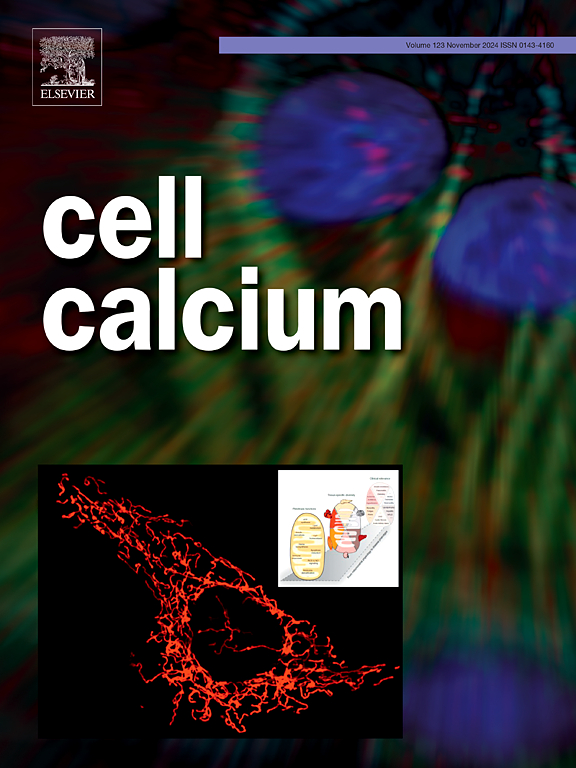Dietary calcium intake controls epithelial expression of TRPV6 independent of 1,25(OH)2D3 endocrine signaling
IF 4
2区 生物学
Q2 CELL BIOLOGY
引用次数: 0
Abstract
Dietary calcium intake modifies the action of active vitamin D [1,25(OH)2D3], which promotes the expression of transient receptor potential vanilloid (TRPV) 6, an epithelial calcium channel, to initiate intestinal calcium absorption in response to biological requirements. However, it is unclear whether the change caused by dietary intake results from endocrine regulation or the direct responses to luminal contents. In this study, to reveal the underlying mechanisms of intestinal calcium transport in response to dietary intake, we assessed the early postprandial responses in mice.
Although mice lacking intestinal vitamin D receptor function (Int Vdr-) exhibited severe calcium deficiency, a high-calcium diet (1 % calcium) containing 2-fold calcium compared to a control diet reversed impaired calcium absorption and compensated for the mechanisms of 1,25(OH)2D3-dependent transcellular calcium transport. Additionally, the calcium-sensing receptor (CaSR) was abundantly present at the basolateral site in the intestine and the signals were emphasized by a high-calcium diet.
To examine the direct response of intestinal epithelium to dietary intake, wild-type (Int Vdr+) and Int Vdr- mice were fed a control or high-calcium diet for 30- or 60-min after 23 h fasting. Serum glucose levels increased 30 min post-feeding in either genotype. TRPV6 expression increased 30 min post-feeding, whereas serum calcium levels were unaltered, suggesting that dietary intake stimulates TRPV6 expression.
These data suggest that the regulation of calcium absorption activated immediately after feeding differs from the mechanism involving endocrine responses. Factors altered in the early phase of feeding, such as glucose, may contribute to the regulation of calcium absorption.

膳食钙摄入控制不依赖于1,25(OH)2D3内分泌信号的TRPV6上皮表达
膳食钙摄入改变活性维生素D的作用[1,25(OH)2D3],促进上皮钙通道瞬时受体电位香兰素(TRPV) 6的表达,以响应生物需求启动肠道钙吸收。然而,目前尚不清楚饮食摄入引起的变化是由内分泌调节引起的,还是对肠管含量的直接反应。在这项研究中,为了揭示肠道钙转运对饮食摄入的潜在机制,我们评估了小鼠餐后的早期反应。尽管缺乏肠道维生素D受体功能(Int Vdr-)的小鼠表现出严重的钙缺乏症,但与对照饮食相比,含钙2倍的高钙饮食(1%钙)逆转了受损的钙吸收,并补偿了依赖1,25(OH) 2d3的跨细胞钙转运机制。此外,钙敏感受体(CaSR)大量存在于肠的基底外侧,高钙饮食强调了信号。为了研究肠道上皮对膳食摄入的直接反应,野生型(Int Vdr+)和Int Vdr-小鼠在禁食23小时后分别饲喂对照或高钙饮食30分钟或60分钟。两种基因型的血清葡萄糖水平均在饲喂后30分钟升高。TRPV6表达在饲喂后30分钟增加,而血清钙水平不变,提示膳食摄入刺激TRPV6表达。这些数据表明,摄食后立即激活的钙吸收调节与涉及内分泌反应的机制不同。在喂养早期改变的因素,如葡萄糖,可能有助于钙吸收的调节。
本文章由计算机程序翻译,如有差异,请以英文原文为准。
求助全文
约1分钟内获得全文
求助全文
来源期刊

Cell calcium
生物-细胞生物学
CiteScore
8.70
自引率
5.00%
发文量
115
审稿时长
35 days
期刊介绍:
Cell Calcium covers the field of calcium metabolism and signalling in living systems, from aspects including inorganic chemistry, physiology, molecular biology and pathology. Topic themes include:
Roles of calcium in regulating cellular events such as apoptosis, necrosis and organelle remodelling
Influence of calcium regulation in affecting health and disease outcomes
 求助内容:
求助内容: 应助结果提醒方式:
应助结果提醒方式:


